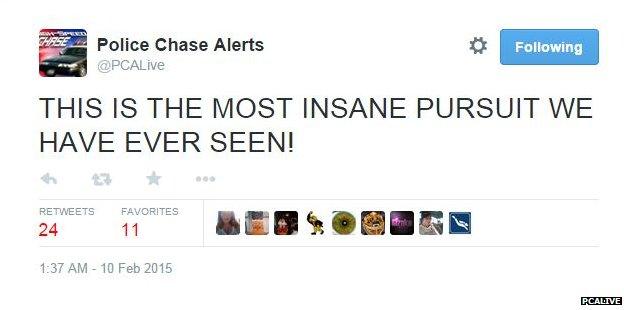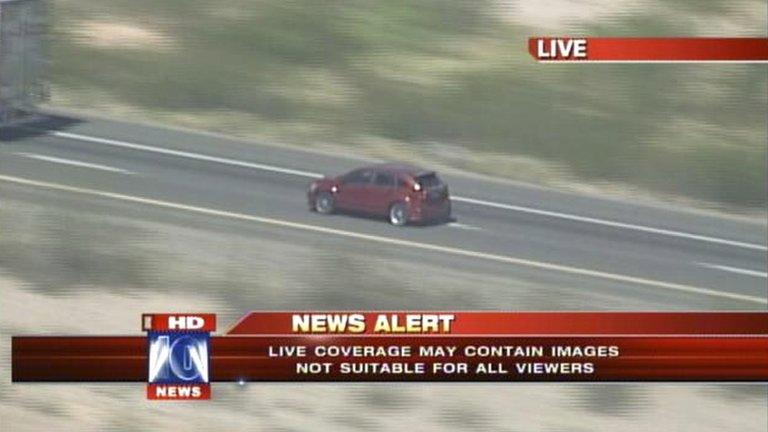Why America loves a police car chase
- Published

When a violent criminal tries to avoid arrest by getting in a car and driving off, any police officer will jump behind the wheel and give chase. But in few countries does the pursuit end up on live TV as often - or for as long - as in the US.
"Woah! Look at that! Extre-e-emely dangerous driving. I have never seen a pursuit as crazy as this."
The TV news commentator could barely disguise his excitement as cameras tailed a runaway driver screeching across Los Angeles on Monday - smashing into vehicles and swerving through oncoming traffic.
"Woah! He's got a weapon! He's just carjacked that vehicle. Live on television. Amazing."
Even in LA - the car chase capital of America - this was an epic. During 25 minutes of breathless rolling coverage, viewers saw the "maniac" driver crash six times and force a terrified young woman out of her vehicle at gunpoint.
The gunman is filmed smashing into other vehicles, firing on officers, stealing a second car and attempting to steal others during the chase
At no point did the cameras stop rolling.
Pictures of office workers huddled round televisions were shared on Instagram and Twitter - including one memorable image of an entire newsroom transfixed by the drama.

"It's a cultural phenomenon. We can't take our eyes of this immoral behaviour!" says Dan Neil, automotive columnist at the Wall Street Journal.
"We all know the outcome - he's going to get caught. The odds are a million to one. And yet still, everyone gathers round the TV. We want to see the finale… the coup de grace."
Live TV police pursuits had a big following even before the OJ Simpson chase in June 1994 brought the phenomenon to global attention.
Some 95 million Americans tuned in to see the NFL legend being slowly driven down the Santa Monica freeway, tailed by more than a dozen highway patrol and police squad cars (see top picture).
But in recent years, news networks have ramped up their coverage - transforming what was once a local news item into a showpiece event. National cable networks interrupt scheduled programming in order to offer live, blow-by-blow commentary from rival helicopters.
Chase fans receive phone alerts and follow dedicated Twitter feeds pointing them to the best news channel to catch the action.

Famous televised chases include a stolen timber lorry which ignited in flames, and a school bus hijacking in Miami where the suspect was killed in a shootout.
The morality of showing this on TV - and the danger of glorifying carjackers - has long been debated. In Los Angeles, police authorities recently urged TV networks to curb their coverage - comparing it to a "bloodsport", external.
But on Monday the local Fox, CBS and NBC stations all screened the chase.
"If they wrestled with their conscience, clearly the conscience lost," says Dan Neil.
"Remember - newsgathering operations here are funded by ratings... That's why you spend $10m (£6.5m) on a helicopter."
During the LA chase we hear the studio newscasters condemn the "maniac" driver, while doing their best to build tension and keep audiences glued to the screen: "What could he be running away from? Could it be more than life in prison he is facing?"
Al Tompkins of the Poynter Institute, who was in the studio chair for the OJ Simpson chase and many others, acknowledges that car chases are fascinating, drawing viewers "like moths to a flame", but he points out that "something awful" is probably going to happen.
"And when it does, it's going to be visual and graphic."
Tompkins has written ethical guidelines for studio news editors on whether or not to cover a chase live. One question they need to ask, he says, is whether the chase is newsworthy - in essence, whether telling the public about the chase makes them safer.
"For local channels, I can understand it. But when national cable networks run a chase that isn't newsworthy... I think that's much harder to defend," he says.
The next question is, if you're going to go live on a car chase "are you prepared to air the worst possible outcome?"
He cites the tragic episode where Fox News showed a man fatally shooting himself in the head after a high-speed chase ending in the Arizona desert. The channel was showing the chase with a five-second delay for safety - but somehow failed to cut away before the suicide.
It is not only at the end of the chase that someone may die. Every year more than 300 people die during police pursuits in the US - including bystanders, other drivers and even TV journalists.
In 2007 two helicopters owned by rival networks collided in mid-air while covering a car chase, external - killing all four people on board.

Wreckage of one of the helicopters that collided in Phoenix, Arizona, in 2007
If a TV station stays with a chase long enough, the odds are they will end up showing something horrific. But plenty of channels show them, and plenty of viewers watch.
The essential appeal is voyeurism says Dan Neil.
"We love the opportunity to pull up a chair and watch the troubles of someone else from a safe distance. And the car chase couldn't be more perfect theatre.
"The view from the helicopter is godlike. It is very seductive to look down on the fatalistic beings below and forget there are people involved.
"I mean - the poor lunatic is out of his mind. But we've managed to make entertainment out of him - sport even. I dare say that somebody's even betting on it somewhere."
This same helicopter view is familiar to players of the original Grand Theft Auto - the wildly popular video game which rewards players for carjacking and murders. But Neil thinks many viewers are cheering for the other side - the cops.
"It appeals to the American sense of rough justice," he says. "There's a moment when everyone wants the bad guys to get their comeuppance."
But while the police accuse news networks of sensationalising pursuits, are the officers themselves ever at fault - for initiating unnecessary car chases?
"Oh every day" says Prof Geoffrey Alpert, at the University of South Carolina, who collects data on pursuits.
"Every day there are these useless chases across America. I'm talking about pursuits for minor offences. Running a red light. I don't believe these chases are necessary or reasonable."
Approximately 40% of pursuits end in a crash, he says. And almost every day in the US there is a death relating to a police pursuit.
"The myth in police pursuit is, 'If he's running he must have something to hide.' We call it 'the dead body in the trunk myth'," says Alpert.
"The other myth is, 'If we don't chase this guy, that's going to encourage everybody else to run.' That's what cops tell me in training."
In fact, despite the city's reputation for dramatic car chases, police in LA now have a policy to chase "only for violent crimes".
In this latest televised chase, Alpert says, the police had no choice.
"He was extremely violent. You saw the trauma on that young woman's face afterwards. He's not the kind of guy you want let free."
Alpert says some people regard police chases as "like Nascar - hundreds of thousands of people watch it waiting for the next crash".
But it is news, so far as he is concerned.
"This has been with us in America since the Wild West. A guy robs the bank and runs away on his horse. So the sheriff gets on his horse and pursues him. That's the way it's always been."
- Published10 February 2015

- Published29 September 2012
